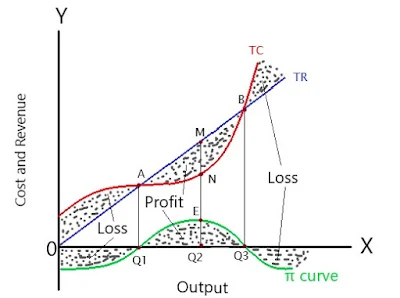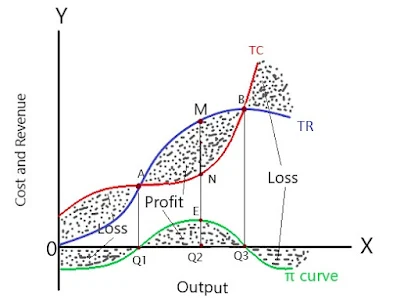1. Total revenue and Total cost approach:-
According to TR-TC approach, a firm gains equilibrium position at that output at which the difference between total revenue and the total cost is maximum. Every rational firm aims to maximize profit.
π = TR-TC
where; π = profit,
TR = Total Revenue and
TC = Total Cost
A. Equilibrium of a firm under perfect competition:-
Perfect competition is the market structure in which there are a large number of buyers and sellers selling homogeneous products. A firm is a small part of the whole industry. Price is fixed by the industry. The firm can sell as much as it wants only at the price fixed by the industry. The total revenue curve is an upward sloping line which increases at the same rate in this market. It is generally assumed that Total Cost Curve is inversely ‘S’ shaped. A firm attains equilibrium at that point at which the difference between TR and TC is maximum. It can be presented with the help of the following diagram:-In the above figure, TR and TC represent Total Revenue and Total Cost curves. The difference between TR and TC is measured by the vertical distance between TR and TC. Up to OQ1 level of output, the firm bears loss because Total Cost is higher than Total Revenue. Between OQ1 and OQ3 level of output, the firm is in profit because TR is higher than TC. The firm earns maximum profit at OQ2 level of output which is shown by the vertical gap MN. The firm is in equilibrium at OQ2 level of output at point E which is shown in the π curve (profit curve).
B. Equilibrium of a firm under monopoly:-
Under monopoly, a firm determines the price of its product itself. The monopoly firm increases its price to increase the revenue or may decrease the price to increase its sales. Therefore, TR curve is inverse ‘S’ shaped. The firm chooses that level of output at which the profit is maximum. The profit is maximized when there is a greater vertical distance between TR and TC curves. It can be explained by the help of the following diagram:-In the above figure, TR and TC represent Total Revenue and Total Cost Curve. π curve represents the profit curve. Before OQ1 and after OQ3 level of output, the firm bears loss because the total cost is higher than total revenue. From OQ1 to OQ3 level of output, the firm enjoys profit because TR is higher than TC. The maximum profit is the vertical gap MN which is also represented in the π curve as Q2E. The firm is equilibrium at this level of output and does not want to deviate from this point.



0 Comments
If this article has helped you, please leave a comment.